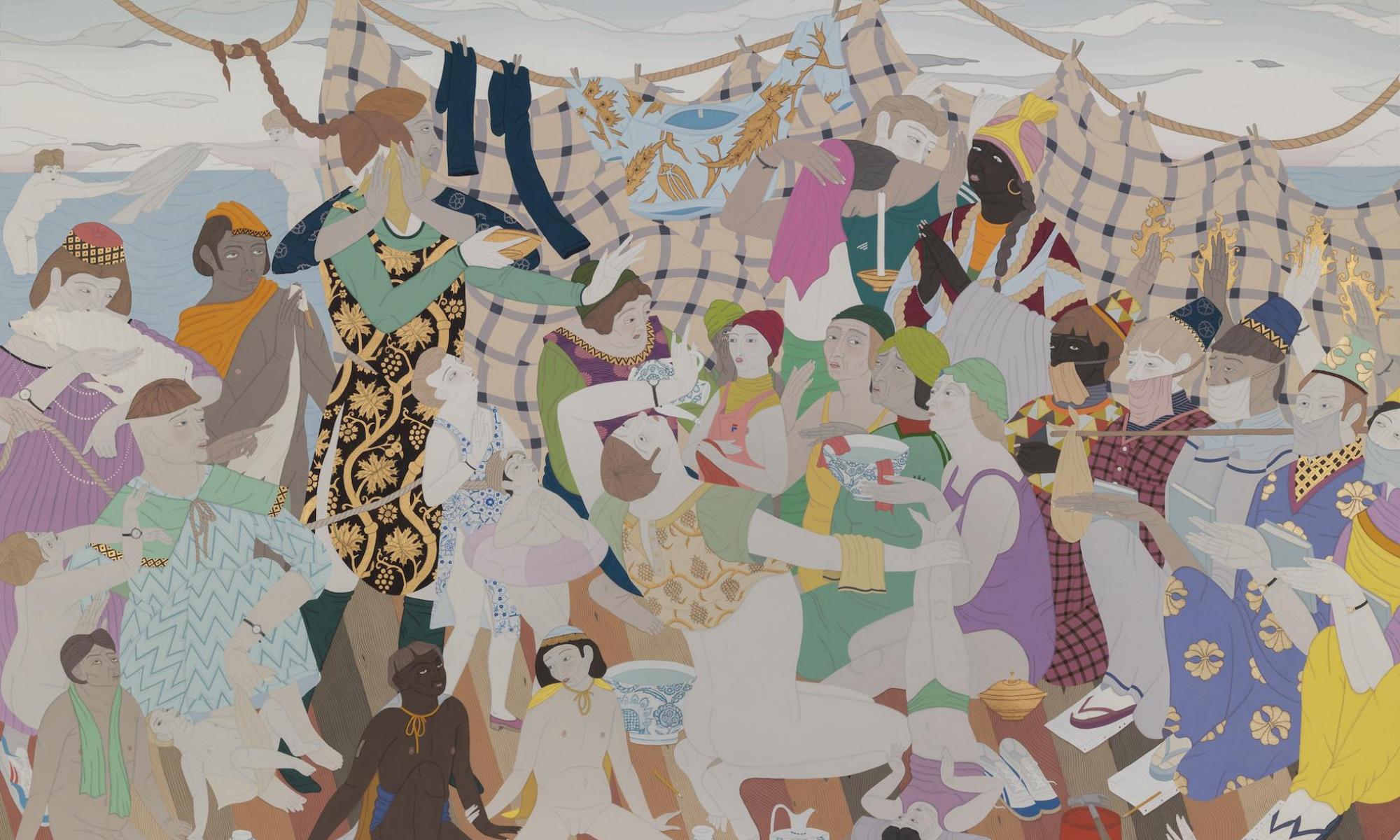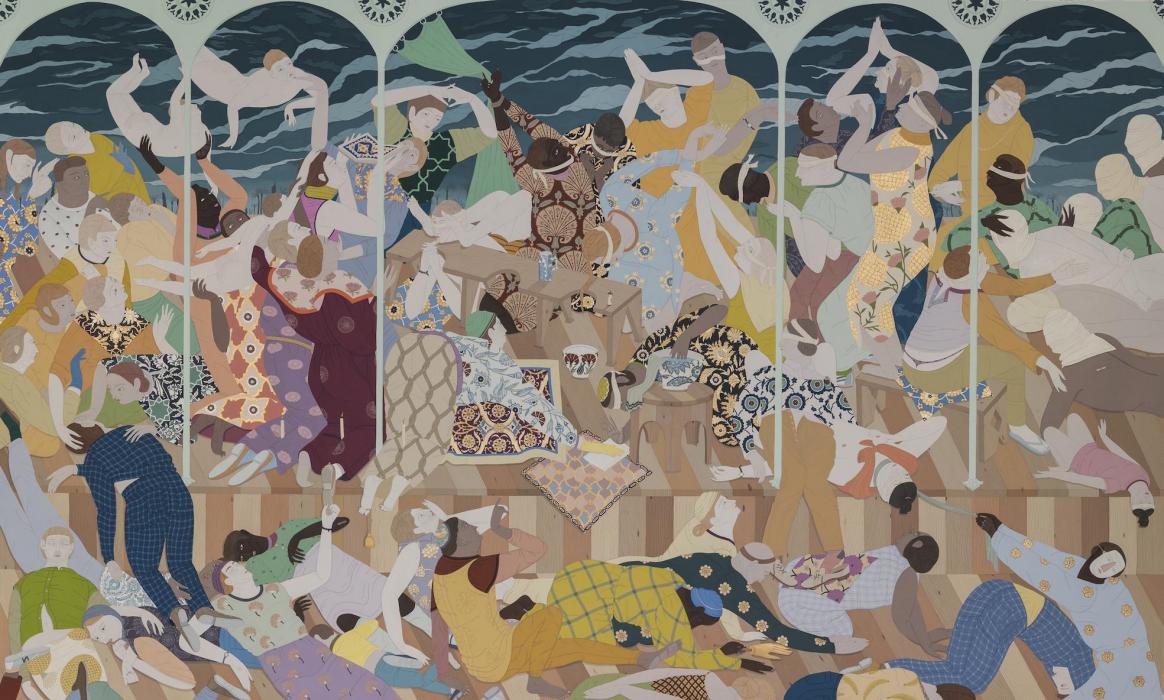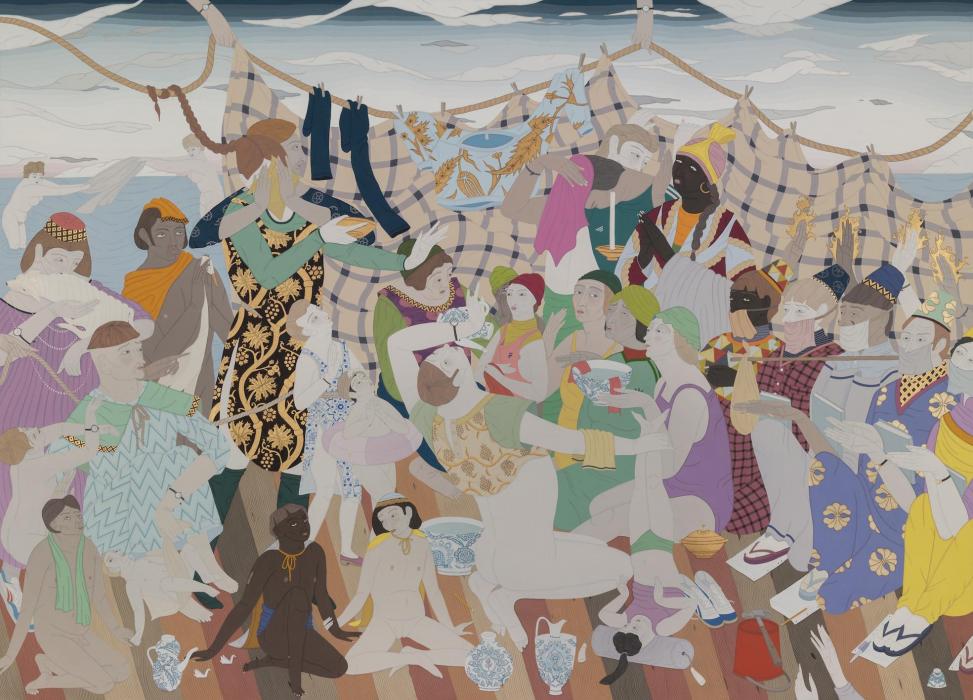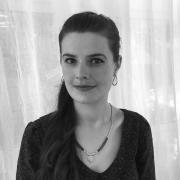Review: Kushana Bush, The Burning Hours
The Burning Hours, a solo exhibition of paintings by Kushana Bush at Te Uru Waitakere Contemporary Gallery in Auckland, takes its name from Christian devotional books popular in the Middle Ages. These illuminated manuscripts, which bore names such as The Beautiful Hours, The Very Rich Hours, The Small Hours, and The Black Hours, were private prayer books to be used at the divine office.
The divine office describes the intervals of solemn prayer celebrated by Catholic monks and clerics each day.(1) Each office, or canonical hour, consecrates a moment of the day—sunrise, the start of work, mid-morning, noon, mid-afternoon, sunset, rest, night—sanctifying each interval with hymns, readings, and psalms. During the Middle Ages, devoted laypeople often partook of the divine office, and wealthier classes had lavishly decorated prayer books complete with miniature paintings.(2)
In The Burning Hours, Bush transforms these historical manuscripts into paintings with names like The Covered Hours, The Albino Hours, and The Hazing Hours. But rather than illustrating biblical scenes, Bush’s paintings depict groups of people partaking in new kinds of ritual observances. Sometimes, the rituals are recognizable and contemporary. The hose-and-funnel apparatus of The Hazing Hours, for example, looks suspiciously like a Scarfie(3) orientation week event. Other rituals gesture toward historical or religious themes, with scenes of exorcism, circumcision, and divination. Many of the ceremonies in Bush’s paintings are more obscure and perplexing: whole crowds of people with thin noses and tiny mouths sacrifice animals, parade holy men, immolate unlucky scapegoats, flog and derobe victims, and put on curious plays.
Curated by Lauren Gutsell of the Dunedin Public Art Gallery, The Burning Hours is the first major solo show of Kushana Bush’s paintings to travel public galleries in New Zealand. It also marks a distinctive development in Bush’s style, which occurred between 2014 and 2016. For the first time, figures crowd the paper from the centre to the edge in pre-perspective style. Bodies are clothed in vivid textiles and patterned upholstery from historical sources; colours are flat and lines sharp, almost creating the illusion of folded paper. Gold leaf adorns small objects, casting light on the characters within the paintings as well as us outside. Chaotic, playful, decorative, and intimate, the works which comprise the exhibition draw the viewer in with their singular style.
Although Bush’s paintings evoke something of the religious atmosphere from which European miniature paintings were born, and although some of the paintings have church-like architectural backdrops, and although the paintings themselves operate as valuable cultural artefacts which demand a certain reverence, Bush does not allow these contexts to consecrate her subject matter entirely. The scenes she paints have as much humour and profanity as hallowed ambience. Wristwatches, Nike sports logos, and swimming caps pepper the crowds; rampant mobs seize their victims with umbrellas, brooms, brushes, and plungers.
The contemporary objects, brands, and clothing items littered across the collection of paintings remind the viewer that the strange characters and their detailed narratives are not merely historical. We still participate in rituals, the paintings tell us, albeit invisible ones. My new office companion, for example, turning on the Radio New Zealand news bulletin at every hour; the Saturday afternoons I spend lifting Les Mills branded barbells in time with 750 people in a pre-recorded TV studio in Stockholm; my weekday lunchtime congregation outside the Korean pancake stall.
Who are Bush’s people, and how closely do we really resemble them, or they, us? Their willingness to partake in violent beatings, beheadings and immolation is an unnerving and unappealing reflection—if, indeed, it is a reflection. The collapsing of time and place in Bush’s paintings makes it difficult to say how closely we might be related. Among the figures, which stack vertically and reach right to the edge of the paper, cultural references from diverse societies abound: from skull caps to fezzes to tennis visors; paper lanterns to Turkish ceramics; roman sandals to New Balance shoes. The painting style itself takes influence from traditions as different as Mughal India, Renaissance Italy, medieval France, early modern Japan, with architectural and textile details displaying another layer of aesthetic influence.
In this way, the suite of paintings evades the impulse to class its inhabitants and scenes as medieval/contemporary, archaic/modern. The diversity of sources is woven into a signature style. The breadth of time and space between each historical source seems to suggest the limitations and the specificity of our present-day categories of group identity, centred as they are on nation states and ethnic groups.
In fact, Bush’s use of art historical sources highlights the way that categories of kinship and identity have always been complicated by intercultural exchange. As we know, the rise and fall of empires hinges, in a large part, on their interaction with and access to the technological, philosophical, and artistic developments of other cultures. But the Kushan Empire (c. first to third centuries CE), after which Kushana Bush is named, did more than just accumulate or appropriate the artworks and literature of its subjects, it famously amalgamated the diverse religious and artistic traditions. Reigning over parts of present day Afghanistan, Pakistan, and northern India, the syncretic Empire had cultural influences as diverse as Greek, Iranian, and Indian.(4)
Bush’s crowded scenes reflect something of the chaotic syncretism of the Kushan Empire and its antecedent polities. And like many of the Kushan Empire’s artefacts, her paintings complicate divisions on which identity is staked. What contemporary groups can legitimately claim kinship to the Greco-Buddhist sculptures of Gandhara, for instance? Bush’s paintings provoke the viewer to imagine in what ways they might claim kinship to the characters and scenes, while at the same time, evading the possibility that one can wholly identify with any scene.
Unlike the illuminated manuscripts in which Biblical narratives spoke to Christian devotees, the implied viewer of Bush’s paintings has a complex and confusing identity. Perhaps the paintings address a cosmopolitan subject whose access to the wealth of many cultures makes them variable, ungrounded—a ‘well-educated’, ‘globally-minded’ product of liberal, individualistic social agendas. But perhaps the paintings also tell this subject that they are not exceptional, and that the riches of preceding ages are not theirs to inherit.
Kushana Bush’s work is also represented at the NGV Triennial, Melbourne, until April 15, 2018.
(1) Oury, Guy-Marie. ‘Divine Office’. Encyclopedia of the Middle Ages. Edited by André Vauchez, Barrie Dobson, and Michael Lapidge. Cambridge, England: James Clarke, 2000.
(2) ‘Book of Hours’. Britannica Academic, Encyclopædia Britannica. 27 Feb. 2013. academic.eb.com.ezproxy.auckland.ac.nz/levels/collegiate/article/book-of-hours/80655. Accessed 16 Jan. 2018.
(3) Local term for a University of Otago student.
(4) ‘Kushan Art’. Britannica Academic, Encyclopædia Britannica. 6 Apr. 2012. academic.eb.com.ezproxy.auckland.ac.nz/levels/collegiate/article/MTV/46506. Accessed 6 Jan. 2018. It is important to note that the cultural and religious syncretism of the Kushan Empire did not appear unprecedented: the region had long been in dialogue with civilizations as far west as Persia and Greece when it was united under one polity during the reign of Alexander the Great (c. 336-323 BCE), and before that, the Achaemenid Empire (c. 550-330 BCE).



_0-itok=dDqeHc-A.jpg)
_0-itok=L1nCrs3V.jpg)

